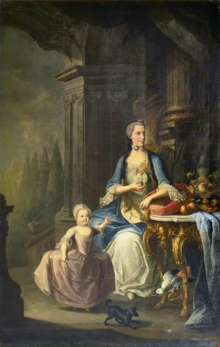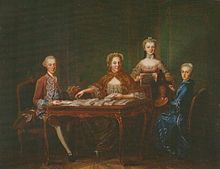Princess Isabella of Parma
In them, she discussed philosophy, religion, ethics, politics, diplomacy, military theory, world trade, education and childrearing, human culture and societies, and the position of women.Although her husband loved her, she did not fully return his feelings and found more fulfillment in her (likely romantic, possibly sexual) relationship with her sister-in-law, Archduchess Maria Christina.Despite her popularity at the Viennese court, the shame and guilt inspired by her inability to reciprocate her husband's feelings, compounded by the same-sex attraction that she considered sinful, made her unhappy.A lonely childhood with demanding and unaffectionate caretakers, the sudden loss of her mother, a difficult birth and two miscarriages in the span of ten months, and later a fourth pregnancy all adversely affected her physical and mental health.Madame Infante was ambitious and strong-willed, unlike her husband, and soon took on a leading role in the marriage, working through to secure a higher position for themselves[2] and more power for the Bourbons.[3] She had a contentious relationship with her mother-in-law Elisabeth Farnese, the de facto ruler of Spain, whom she threatened in her influence over her son, but they worked together to advance Philip's career.[6] Based on these letters, her mother never displayed warmth towards Isabella, and was impatient with her; when the child threw tantrums, she chastised her so severely that Queen Elisabeth called it a 'military drill'.Their spirit is brilliant and full of fire, it is capable of designing anything with promptness and accuracy, it is vast, it understands everything, it is precise, few things escape it, it is inventive in every way.[24] She was officially urged by the Marshal of France, Adrien-Maurice de Noailles, to show more love to Isabella, as it was feared that rumours about her cold treatment could diminish the chances of a politically advantageous marriage.[28] Isabella was instructed by her confessors, Fathers Fumeron and Belgrado, in the lives of the saints, and she continued to practice drawing, painting, and music with her aya; she excelled at singing and playing the violin and the harpsichord.[29] While there is no proof that she attended lectures by Keralion and Condillac, Badinter argues that her later knowledge of military theory, history, and Enlightenment ideals shows that she did.Influenced by Madame de Pompadour, Louis XV decided to shift alliances and join Austria against Britain and Prussia in the Diplomatic Revolution.[36] Her bridegroom Joseph wrote to a friend that he would try to win his bride's 'respect and trust', but he considered it impossible for himself to be 'agreeable, to pose as a lover', as that went against his 'nature' which had never understood romantic love.[37] I am extremely worried about my future happiness; I am certainly not entering this [married] state out of curiosity or bestial lust; only the thought of duty brings me to this, which costs me infinitely and disgusts me.[41] At night, there was a display of decorative lighting with almost three thousand lanterns burning between the Hofburg and the Stephansdom and the same amount of white wax candles in two lines, complete with torches in the courtyard of the palace.[42] This was organised despite the ongoing Seven Years' War draining the treasury, as Maria Theresa wished to distract attention and display the wealth of her empire.[48] In early March 1763, was reported in France that she was psychologically unwell, still grieving her last miscarriage, and displaying physical symptoms: she was 'extremely thin', had an 'almost constant' 'dry cough', and pain in her sides.[52] Despite living in the same palace, they exchanged letters and small notes daily, which Freyermuth connects to the popularity of intimate correspondence and epistolary novels at the time.[51] Badinter argues that possessive desires, feeling pain over being separated, an 'obsession with the beloved', jealousy, and dependency—seen as characteristics of romantic-sexual relationships both in the 18th century and since then—were apparent in their correspondence.She relied on the French pronoun on ('one'), to make her declarations impersonal: 'when one sees you [on vous voit], one can no longer be [on ne plus peut être] occupied by anything but your charms'.[64] The Infanta was intelligent and educated, and studying sciences had been Marianne's refuge from her lonely and contentious family life, an interest that connected her with her father, who now also adored Isabella.[60] She took care of her daughter until she died in childhood, and married Prince Albert Casimir of Saxony in 1766[74] Later, she wrote that Isabella's death was 'to the great regret of all, but above all of me'.[75] In 1758, French historian Pierre-Jean Grosley visited Parma and described Isabella as 'one of the main wonders' of the city because of her 'marked talent' in all 'useful and pleasurable arts' and her 'good knowledge of the world'.[76] Freyermuth argues that the travels she undertook as a child and her diverse experiences in Spain, France, Parma, and later Austria stimulated her intellectual development and her critical thinking skills.[50] During negotiations for her marriage, Austrian observers reported that Isabella spoke French, Spanish, Italian, and some Latin, studied sciences and maps, and followed military movements in Austria's ongoing Third Silesian War.[50] She enjoyed dancing at balls but not card games, horse-riding, or hunting (all popular forms of entertainment in European royal courts of the time), preferring brisk-paced walks as physical exercise.[38] When her best friend and possible lover, Archduchess Maria Christina, wrote a description of Isabella, she mentioned being biased in favour of those she loved and being reluctant to change her opinions among her negative traits.[82] Reflections on Education was Isabella's rejection of the contemporary upbringing of upper-class children and a covert condemnation of her own parents and the teachers they hired, especially the abusive tutors of her brother Ferdinand.[84] She considered corporal punishment (which her parents had embraced) to be futile and dangerous, a form of discipline originating in 'hardened hearts' and 'lowly sentiments', based on the 'false belief' that humans are 'no better than animals' and cannot be persuaded through reason.In her opinion, a man is born to think but instead spends his life 'with entertainment, yelling, playing heroes, running up and down, in other words, doing nothing but what flatters his vanity or requires no thought of him'.
















Archduchess of AustriaJean-Marc NattierBuen Retiro PalaceMadridKingdom of SpainHofburgViennaArchduchy of AustriaHoly Roman EmpireImperial CryptCapuchin Church, ViennaAustriaArchduke Joseph of AustriaArchduchess Maria TheresaSpanishGermanFrenchBourbon-ParmaPhilip, Duke of ParmaLouise Élisabeth of FranceprincessinfantaHouse of Bourbon-ParmaLouise-Élisabeth of Francearchduchesscrown princessBohemiaHungaryJoseph II, Holy Roman EmperorEnlightenmentethicsromanticsexualsister-in-lawMaria ChristinaViennesesame-sex attraction that she considered sinfulmiscarriagesmelancholicsuicidal ideationdepressionbipolar disordergeneticallysmallpoxPhilip of SpainMaria Isabel Ana of Naples and SicilyThe Family of Philip VLouis Michel van Loofirst cousins once removedLouis XV of Franceheir apparentPhilip V of SpainElisabeth Farnesede factolabourWar of the Austrian SuccessiontantrumschastisedgovernessMarquisesuo juremarquise of Borghettoetiquettehierarchydame d'honneurBarbara of Portugalcorporal punishmentbutterflieshorse-ridingÉlisabeth BadinterVersaillesLouis XVMarie LeszczyńskatheatreconcertsPaul d'Albert de LuynesFrench royal princessroyal guardMaria Josepha of SaxonyTreaty of Aix-la-Chapelleduke of ParmaFerdinandDucal Palace of ColornoteethingPalazzo della PilottaPalazzo del GiardinoMarshal of FranceAdrien-Maurice de NoaillescomedyJesuitAuguste de KeralioRousseauDiderotd'Alembertconfessorssaintsharpsichordmilitary theoryMaria Theresa, Holy Roman EmpressBourbonsHabsburgsMadame de PompadourBritainPrussiaDiplomatic RevolutionJosephMaria Luisa of SpainnegotiationsbetrothalHabsburg monarchyongoing war with PrussiaWolfgang Amadeus Mozartmarriage by proxyJoseph Wenzel I, Prince of LiechtensteinOberhofmeisterinwidowedCountessErdődyBattyhányFrancis I, Holy Roman EmperorLaxenburg castlesMaria AnnaallegoricAugustinekircheNuncioVitaliano Borromeo